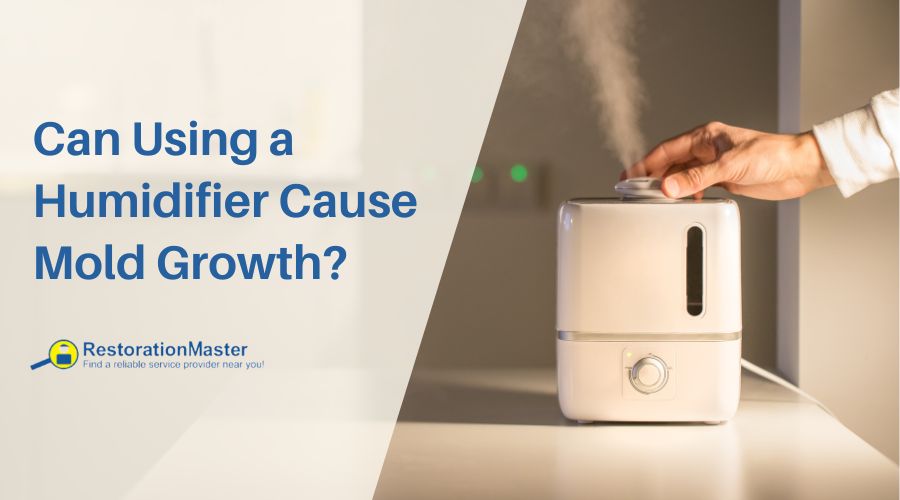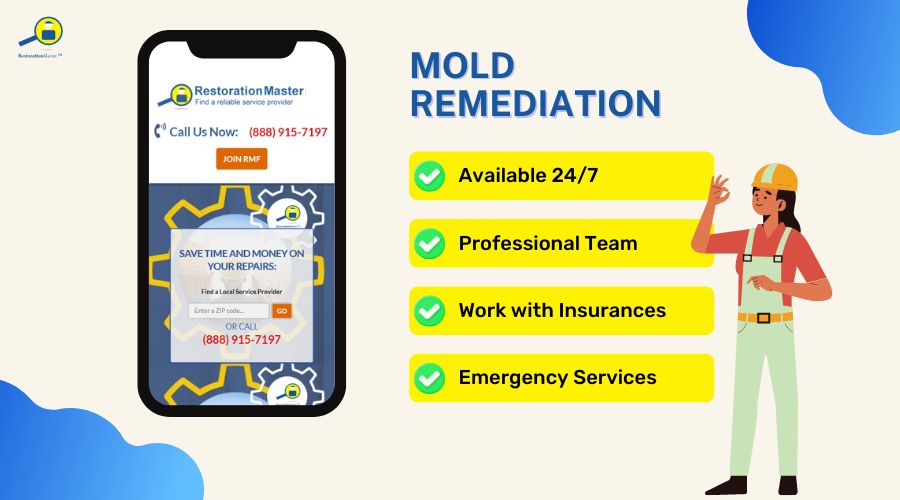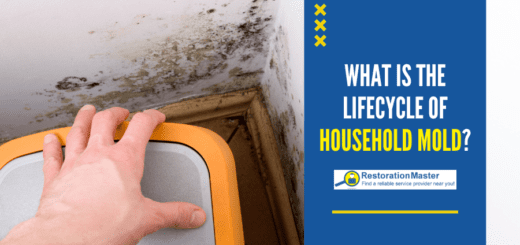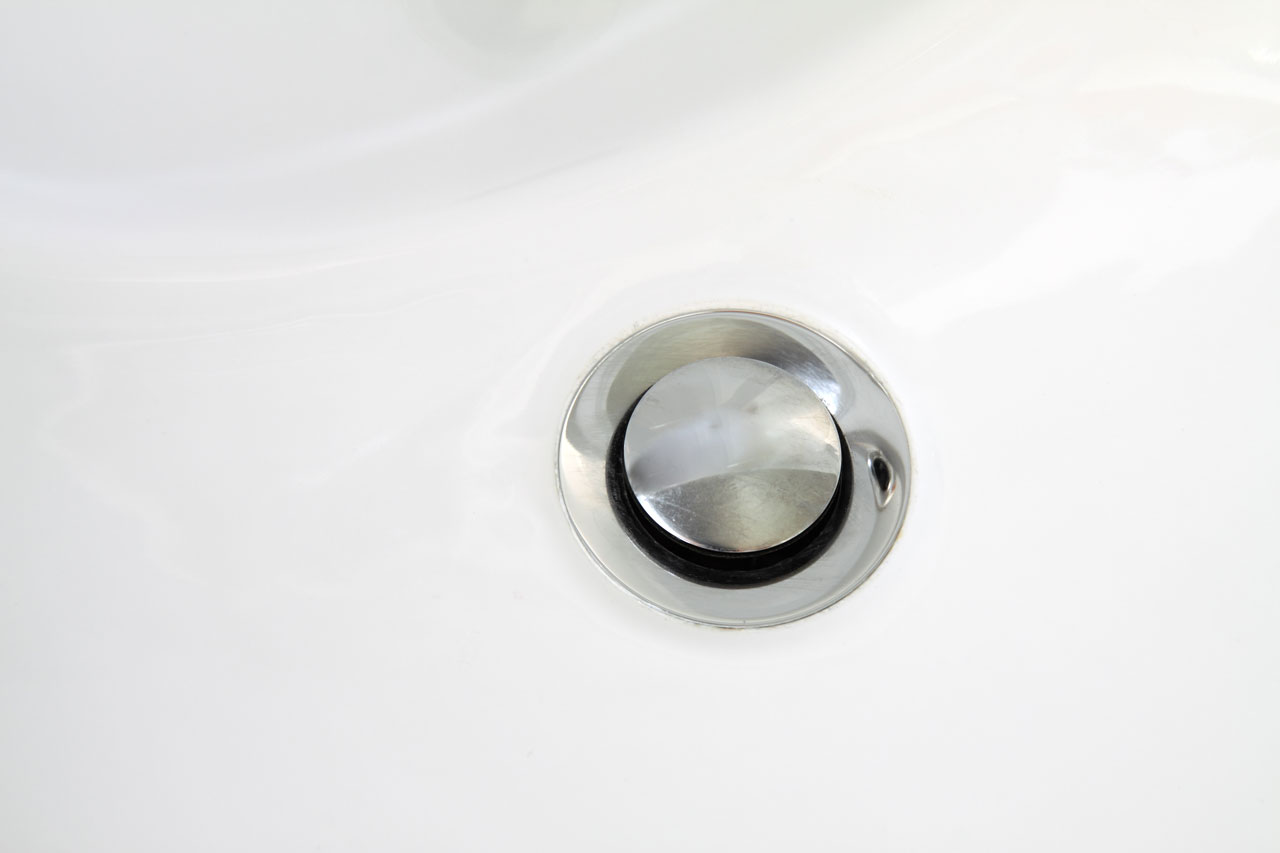Can Humidifiers Cause Mold Growth?

Humidifiers can be a lifesaver in dry climates or during the winter months, helping relieve dry skin, ease congestion, and improve indoor comfort. But here’s the catch: if you don’t use or maintain your humidifier correctly, you may be creating the perfect conditions for moldMold is a type of fungus that grows in damp or humid conditi... More growth in both the appliance and your home. When moisture levels are too high or the device isn’t cleaned regularly, moldMold is a type of fungus that grows in damp or humid conditi... More can develop inside the humidifier and on surrounding surfaces, affecting both your home and health. If you suspect humidifier-related moldMold is a type of fungus that grows in damp or humid conditi... More, contacting a certified mold remediation expert is the safest way to restore healthy indoor air qualityIndoor air quality (IAQ) refers to the condition of the air ... More.
In this guide, we’ll cover:
- The science behind humidifiers and moldMold is a type of fungus that grows in damp or humid conditi... More
- Signs your humidifier may have moldMold is a type of fungus that grows in damp or humid conditi... More
- How to prevent moldMold is a type of fungus that grows in damp or humid conditi... More growth
- Safe cleaning methods
- When to call a professional mold remediationMold remediation is the process of identifying, removing, an... More service
Do Humidifiers Cause Mold?
Humidifiers themselves don’t directly cause moldMold is a type of fungus that grows in damp or humid conditi... More, but they add moisture to the air, and excess moisture is mold’s best friend. When indoor relative humidityRelative humidity (RH) is the percentage of moisture in the ... More (RH) stays above 60% or a humidifier’s water tank isn’t cleaned often, moldMold is a type of fungus that grows in damp or humid conditi... More sporesSpores are microscopic reproductive units of fungi or mold t... More can germinate in as little as 24–48 hours. These sporesSpores are microscopic reproductive units of fungi or mold t... More can spread through the air, land on damp surfaces, and begin growing in walls, ceilings, and even HVAC systems.
Key moldMold is a type of fungus that grows in damp or humid conditi... More risk factors from humidifier use:
- Stagnant water in the reservoir: When water sits too long in your humidifier, it becomes the perfect hangout spot for moldMold is a type of fungus that grows in damp or humid conditi... More and bacteria.
- High humidityHumidity is the amount of moisture or water vapor present in... More settings: Cranking your humidifier too high can turn your home into a mini rainforest—great for moldMold is a type of fungus that grows in damp or humid conditi... More, not for you.
- Poor air circulation in the room: Without good airflow, moisture lingers in the air and settles on surfaces, giving moldMold is a type of fungus that grows in damp or humid conditi... More the green light to grow.
- Use of tap water with mineral content: Tap water often leaves behind minerals that can feed moldMold is a type of fungus that grows in damp or humid conditi... More and create stubborn buildup inside your humidifier.
- Dirty or clogged filters: A neglected filter can become a moldMold is a type of fungus that grows in damp or humid conditi... More motel, sending sporesSpores are microscopic reproductive units of fungi or mold t... More right back into the air you breathe.
What is Mold and Why is it a Concern Indoors?
MoldMold is a type of fungus that grows in damp or humid conditi... More is a type of fungus that thrives in moist, oxygen-rich environments. Outdoors, it plays an essential role in breaking down organic matter. Indoors, however, moldMold is a type of fungus that grows in damp or humid conditi... More can grow on surfaces like drywall, wood, and paper, feeding on building materials and causing property damage. MoldMold is a type of fungus that grows in damp or humid conditi... More is commonly found in areas with high humidityHumidity is the amount of moisture or water vapor present in... More and darkness, such as basements and crawl spaces.
The Health Hazards Associated with Mold
It is important to be aware of the health risks associated with moldMold is a type of fungus that grows in damp or humid conditi... More, despite it being a common sight in many homes. Although surface moldMold is a type of fungus that grows in damp or humid conditi... More may not cause effects in healthy adults, individuals with allergies, asthma, or other respiratory conditions have a higher risk of experiencing reactions. Individuals who are children, seniors, or have pre-existing respiratory diseases may be more sensitive to moldMold is a type of fungus that grows in damp or humid conditi... More sporesSpores are microscopic reproductive units of fungi or mold t... More in the air. MoldMold is a type of fungus that grows in damp or humid conditi... More exposure can cause respiratory symptoms like coughing and wheezing, potentially worsening existing conditions.
By understanding the behavior of moldMold is a type of fungus that grows in damp or humid conditi... More and how to prevent its growth, we can maintain a healthy living environment and avoid the negative effects that it can cause.
Optimal Humidity Levels for a Mold-Free Home
The U.S. Environmental Protection Agency recommends keeping indoor humidityHumidity is the amount of moisture or water vapor present in... More between 30% and 50%. This range is comfortable for people but hostile to moldMold is a type of fungus that grows in damp or humid conditi... More growth.
| Relative HumidityRelative humidity (RH) is the percentage of moisture in the ... More (RH) | MoldMold is a type of fungus that grows in damp or humid conditi... More Risk | Recommended Action |
|---|---|---|
| 20–30% | Low – Air too dry | Increase humidityHumidity is the amount of moisture or water vapor present in... More gradually |
| 30–50% | Ideal – Low risk | Maintain with monitoringMonitoring is the ongoing observation and measurement of con... More |
| 50–60% | Moderate – Risk rises | Lower humidifier output |
| 60%+ | High – MoldMold is a type of fungus that grows in damp or humid conditi... More likely | Use a dehumidifierA dehumidifier is a device that removes excess moisture from... More immediately |
Pro Tip: Place a digital hygrometer in the same room as your humidifier to track humidityHumidity is the amount of moisture or water vapor present in... More in real time.
Types of Humidifiers and Their Mold Risk
There is a common belief that humidifiers cause moldMold is a type of fungus that grows in damp or humid conditi... More, but moldMold is a type of fungus that grows in damp or humid conditi... More in a humidifier is often a result of poor maintenanceMaintenance is the routine care, inspection, and repair of a... More or high levels of humidityHumidity is the amount of moisture or water vapor present in... More in the home. As previously mentioned, moldMold is a type of fungus that grows in damp or humid conditi... More relies on moisture for growth. Humidifiers add moisture to the air, which can create favorable environments for moldMold is a type of fungus that grows in damp or humid conditi... More to prosper.
| Humidifier Type | MoldMold is a type of fungus that grows in damp or humid conditi... More Risk | Notes |
|---|---|---|
| Ultrasonic | High | Mineral dust and stagnant water issues |
| Evaporative | Medium | Lower risk, but filters need frequent changes |
| Steam Vaporizer | Low | Heat kills many microbesMicrobes are microscopic organisms, including bacteria, fung... More, but tanks still need cleaning |
5 Signs of Mold in a Humidifier
Identifying moldMold is a type of fungus that grows in damp or humid conditi... More in your humidifier requires careful inspectionInspection is the careful examination and assessment of a pr... More and observation. Here are some warning signs that you may have moldMold is a type of fungus that grows in damp or humid conditi... More in your humidifier.
- Visible Growth: Black, green, or pink patches inside the tank or nozzle
- Musty Smell: Earthy odorAn odor is a smell, often detectable by the human nose, whic... More in the mist or around the appliance
- Cloudy or Slimy Water: MoldMold is a type of fungus that grows in damp or humid conditi... More can float on the water’s surface and form biofilm
- Allergy Symptoms: Sneezing, itchy eyes, coughing after using a humidifier
- Reduced Performance: Weaker mist output from clogged parts
How to Find Mold In Your Humidifier

How to Prevent Mold Growth in a Humidifier
Proper maintenanceMaintenance is the routine care, inspection, and repair of a... More and smart usage can significantly reduce the risk of moldMold is a type of fungus that grows in damp or humid conditi... More forming in your humidifier and your home. MoldMold is a type of fungus that grows in damp or humid conditi... More not only impacts your family’s health, but it can also cause damage to walls, ceilings, and furniture. Follow these proven strategies to keep your indoor air fresh, clean, and mold-free.
1. Maintain a Regular Cleaning Schedule
Your humidifier should be cleaned at least once a week, and more often if it’s used daily. Empty and rinse the water reservoir each day to avoid stagnant water, which can become a breeding ground for moldMold is a type of fungus that grows in damp or humid conditi... More sporesSpores are microscopic reproductive units of fungi or mold t... More. Once a week, disinfect the tank using a solutionA solution is a homogeneous mixture of two or more substance... More of equal parts white vinegar and water, or a diluted hydrogen peroxide mix. Always follow the manufacturer’s cleaning instructions to avoid damaging the unit, and remember that regular cleaning prevents both mineral buildup and moldMold is a type of fungus that grows in damp or humid conditi... More growth.
2. Replace the Water Regularly Using Distilled or Demineralized Water
Never let water sit in the humidifier between uses. Stale water encourages moldMold is a type of fungus that grows in damp or humid conditi... More and bacterial growth, so replace it daily with fresh, distilled, or demineralized water. These options contain fewer minerals than tap water, reducing the buildup that moldMold is a type of fungus that grows in damp or humid conditi... More can feed on. Rinsing the tank before adding new water helps remove any lingering particles or residueResidue is any leftover material, such as soot, dust, or che... More.
3. Inspect and Replace Filters Regularly
If your humidifier uses a filter, check it often. Filters should be inspected every few weeks for discoloration or odorAn odor is a smell, often detectable by the human nose, whic... More and replaced according to the manufacturer’s recommendations. A dirty or clogged filter can harbor moldMold is a type of fungus that grows in damp or humid conditi... More and bacteria, releasing them directly into the air you breathe, so timely replacement is crucial for maintaining safe indoor air qualityIndoor air quality (IAQ) refers to the condition of the air ... More.
4. Improve Room Ventilation
HumidityHumidity is the amount of moisture or water vapor present in... More without airflow can quickly leadLead is a heavy metal that can be toxic to humans, especiall... More to condensation and damp surfaces, the perfect conditions for moldMold is a type of fungus that grows in damp or humid conditi... More. Place your humidifier in a well-ventilated area and avoid using it in small, enclosed spaces like closets or bathrooms. Running ceiling fans, opening windows, or using exhaust fans can help keep the air moving and prevent moisture from settling on nearby surfaces.
5. Protect Nearby Surfaces
Condensation from a humidifier can affect walls, windowsills, and floors. To prevent damage, place your unit on a non-porous surfaceNon-porous surfaces are surfaces that do not absorb liquids ... More such as glass, plastic, or metal, and keep it at least a foot away from walls or curtains. If you notice moisture collecting on nearby surfaces, wipe it down promptly to discourage moldMold is a type of fungus that grows in damp or humid conditi... More growth.
6. Monitor Humidity Levels
A digital hygrometer is an inexpensive tool that can help you keep humidityHumidity is the amount of moisture or water vapor present in... More in check. The ideal range for most homes is between 30 and 50 percent relative humidityRelative humidity (RH) is the percentage of moisture in the ... More. If levels climb above 60 percent, your risk of moldMold is a type of fungus that grows in damp or humid conditi... More growth increases dramatically, so adjust your humidifier’s settings or reduce usage when needed.
7. Consider an Anti-Mold Humidifier
Some modern humidifiers are designed with built-in moldMold is a type of fungus that grows in damp or humid conditi... More preventionPrevention refers to actions taken to reduce the likelihood ... More features such as SPA technology and antimicrobial filters. These devices can help reduce the risk of moldMold is a type of fungus that grows in damp or humid conditi... More sporesSpores are microscopic reproductive units of fungi or mold t... More being released into the air, particularly in humid climates or homes with allergy-prone residents. While these features add an extra layer of protection, regular cleaning and maintenanceMaintenance is the routine care, inspection, and repair of a... More are still essential.
How to Clean a Humidifier
To keep a humidifier clean, dry, and free of moldMold is a type of fungus that grows in damp or humid conditi... More, users need to have a consistent cleaning schedule. Below are weekly maintenanceMaintenance is the routine care, inspection, and repair of a... More tips users should follow to keep their humidifier clean and working well.
- Unplug and empty the humidifier.
- Fill the tank with 1 part distilled vinegar to 1 part water.
- Let it sit for 1 hour to loosen the buildup.
- Use a soft brush to scrub all surfaces.
- Rinse thoroughly until the vinegar smell fades.
- Let all parts air dry before reassembling.
Safety Tip: Wear gloves and a mask to avoid direct moldMold is a type of fungus that grows in damp or humid conditi... More exposure.
Can Mold from a Humidifier Spread in My Home?
Yes. MoldMold is a type of fungus that grows in damp or humid conditi... More sporesSpores are microscopic reproductive units of fungi or mold t... More released into the air can:
- Enter the HVAC ducts and spread to other rooms
- Settle on damp walls, carpets, and upholstery
- Trigger moldMold is a type of fungus that grows in damp or humid conditi... More growth in hidden areas, like behind furniture
If you notice moldMold is a type of fungus that grows in damp or humid conditi... More odors beyond the humidifier area, professional mold remediation may be necessary.
When to Call a Professional Mold Remediation Service

If you discover moldMold is a type of fungus that grows in damp or humid conditi... More in your humidifier, it’s important to consider the possibility that it may have spread to other areas of your home. MoldMold is a type of fungus that grows in damp or humid conditi... More sporesSpores are microscopic reproductive units of fungi or mold t... More can travel through the air and settle on walls, ceilings, vents, and other damp surfaces, sometimes without immediate visible signs. Certified mold remediationMold remediation is the process of identifying, removing, an... More technicians can inspect your home, perform air quality and surface testing, and develop a targeted plan to eliminate the problem.
Using advanced cleaning methods, HEPA filtration, and negative air pressure systems, they can remove sporesSpores are microscopic reproductive units of fungi or mold t... More, treat affected areas to prevent regrowth, and safely dispose of contaminated materials. This thorough approach not only removes visible moldMold is a type of fungus that grows in damp or humid conditi... More but also eliminates musty odors and restores healthy indoor air qualityIndoor air quality (IAQ) refers to the condition of the air ... More. If you notice lingering moldMold is a type of fungus that grows in damp or humid conditi... More smells, visible spots, or unexplained allergy and asthma flare-ups in your household, contact RestorationMaster today for a free estimate from an experienced mold removal professional in your area.
Frequently Asked Questions (FAQs)
How to prevent pink mold in humidifier?
To prevent pink moldMold is a type of fungus that grows in damp or humid conditi... More in your humidifier:
- Clean Regularly: Wash the unit with water and white vinegar.
- Change Water Daily: Refill with fresh water each day.
- Dry When Not in Use: Store the humidifier in a dry place.
- Replace Filters: Follow the manufacturer’s guidelines for filter replacement.
Can a humidifier cause mold in carpet?
Yes, a humidifier can cause moldMold is a type of fungus that grows in damp or humid conditi... More in carpet if it over-humidifies the room or if there’s a leak. Excess moisture from a humidifier can seep into carpets and padding, creating a damp environment where moldMold is a type of fungus that grows in damp or humid conditi... More can grow. To prevent this, ensure proper ventilationVentilation is the process of exchanging or circulating air ... More, maintain appropriate humidityHumidity is the amount of moisture or water vapor present in... More levels, and regularly check for leaks or spills.












